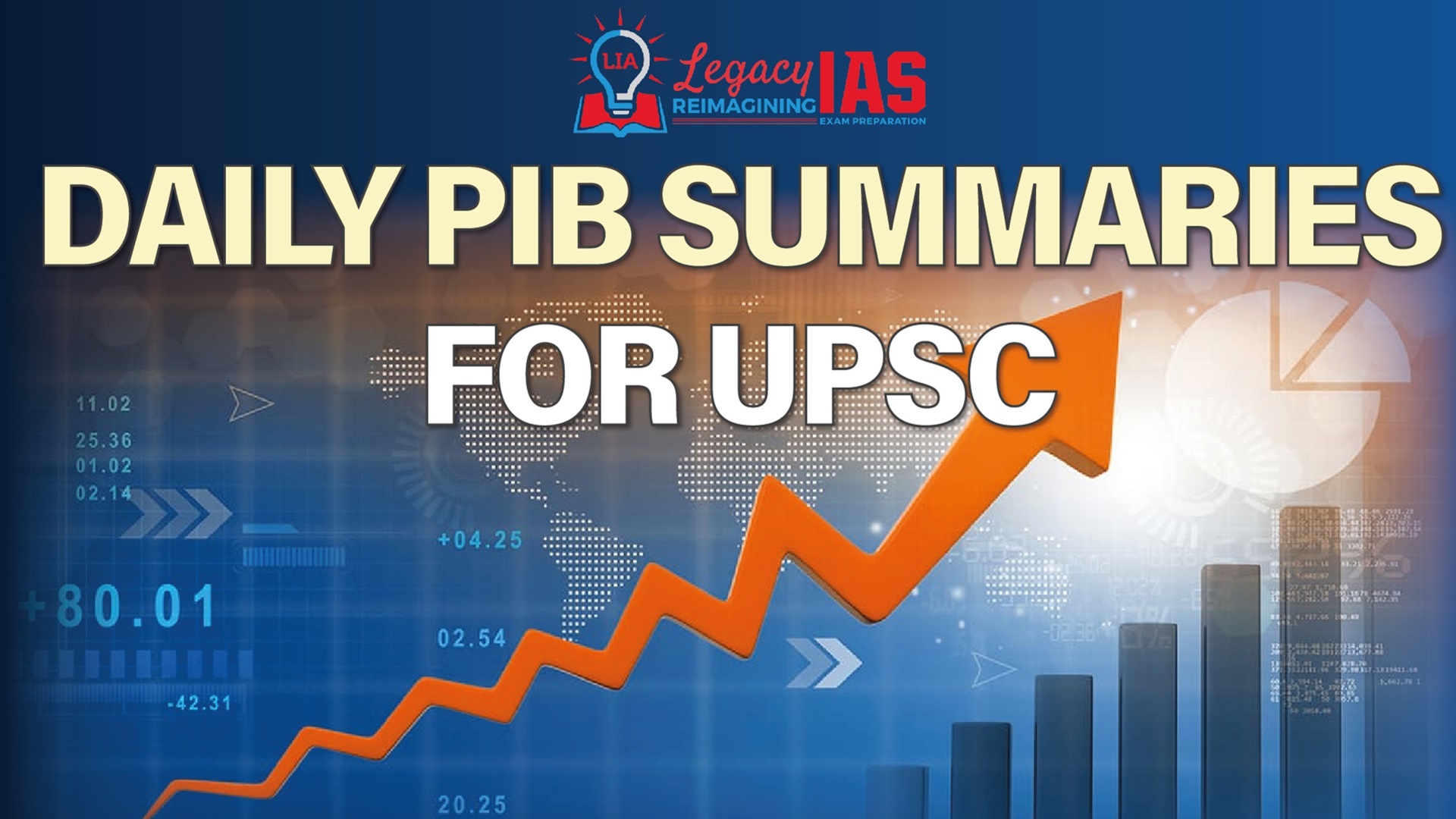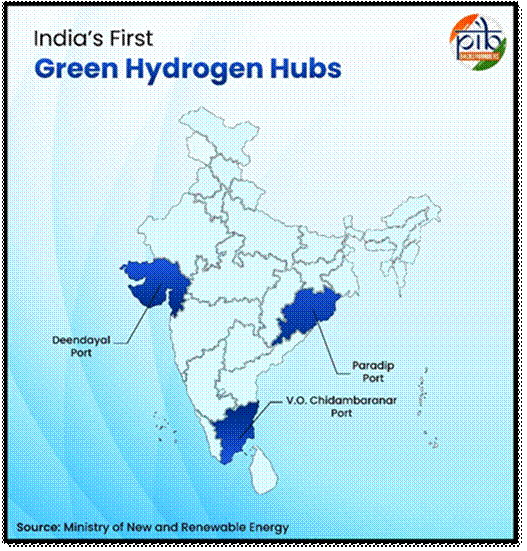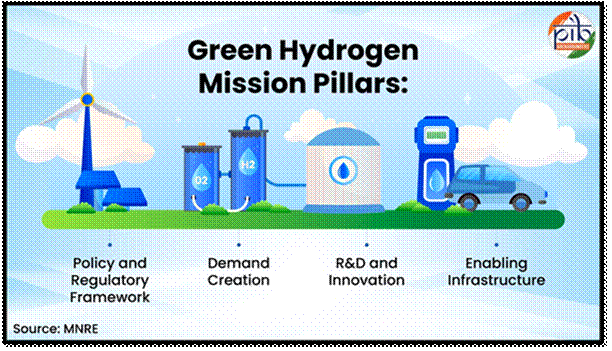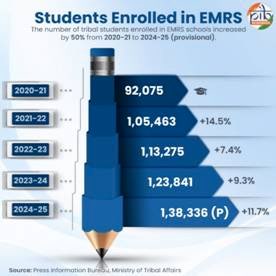Published on Nov 13, 2025
Daily PIB Summaries
PIB Summaries 13 November 2025

Content
- Unlocking India’s Green Hydrogen Production Potential
- From 2 to 597
Unlocking India’s Green Hydrogen Production Potential
Why in News ?
- India commissioned its first port-based Green Hydrogen Pilot Project at V.O. Chidambaranar Port, Tamil Nadu.
- Three ports — Deendayal, Paradip, and V.O. Chidambaranar — declared Green Hydrogen Hubs (MNRE, Oct 2025).
- Targets:
- 5 MMT Green Hydrogen production by 2030
- ₹8 lakh crore investment
- 125 GW renewable energy addition
- 6 lakh jobs
- ₹1 lakh crore import reduction
- 50 MMT CO₂ emissions avoided annually
Relevance : GS 3 – Environment, Energy, Infrastructure
- Renewable energy transition & Net Zero 2070 goals.
- National Green Hydrogen Mission (₹19,744 crore) – decarbonising industry, transport, shipping.
- Port-based hydrogen hubs (Deendayal, Paradip, Tuticorin).
- R&D under SHIP with BARC, ISRO, IITs for indigenous tech.
- ₹8 lakh crore investment, 6 lakh jobs, 50 MMT CO₂ reduction.
- Strategic exports to Japan, Korea, EU – energy security & Atmanirbharta.

Understanding Green Hydrogen
| Type | Source Energy | Emissions | Example |
| Grey Hydrogen | Natural gas (steam methane reforming) | High CO₂ | Current majority of hydrogen production |
| Blue Hydrogen | Fossil fuels + Carbon Capture & Storage (CCS) | Moderate | Transitional fuel |
| Green Hydrogen | Renewable energy (solar/wind) via electrolysis of water | ≤2 kg CO₂ eq per kg H₂ | Cleanest form |
Definition (India Standard 2023):
- Hydrogen qualifies as green if lifecycle emissions ≤ 2 kg CO₂-e/kg H₂.
- National Green Hydrogen Mission (NGHM) – Overview
- Launched: January 2023
Outlay: ₹19,744 crore (FY 2023–30)
Mission Objectives
- Make India a global hub for Green Hydrogen production, use, and export.
- Achieve energy self-reliance (Atmanirbharta) by reducing fossil imports.
- Enable industrial decarbonisation in hard-to-abate sectors: steel, fertilizer, refining.
- Create new green jobs and boost domestic manufacturing.

Mission Architecture
| Component | Outlay (₹ crore) | Objective |
| SIGHT Programme | 17,490 | Incentives for green hydrogen and electrolyser manufacturing |
| Pilot Projects | 1,466 | Demonstration in industry, mobility, shipping |
| R&D / Innovation (SHIP) | 400 | Collaborative research across value chain |
| Other Components | 388 | Skill, policy, infrastructure, certification |
Sectoral Implementation
(A) Industrial Sector
- Fertilizers: 7.24 LMT green ammonia procurement auctioned (₹55.75/kg).
- Steel: 5 pilot projects with PSUs & private firms to test hydrogen-based iron reduction.
- Refineries: Gradual substitution of grey hydrogen with green hydrogen.
(B) Mobility & Transport
- Road Transport: 37 hydrogen-powered vehicles (15 fuel-cell, 22 ICE) across 10 routes; ₹208 crore support.
- High-Altitude Mobility: NTPC’s Leh hydrogen project (3,650 m altitude) — world’s highest; reduces 350 MT CO₂/year.
- Shipping:
- Tuticorin Pilot (2025): 10 Nm³/hr H₂ plant + EV charging from hydrogen.
- Green Methanol Bunkering: ₹42 crore project to create Coastal Green Shipping Corridor (Kandla–Tuticorin).
Policy and Regulatory Framework
| Framework | Purpose | Nodal Agency |
| Green Hydrogen Certification Scheme (GHCI), 2025 | Certifies hydrogen as “green” based on lifecycle GHG emissions | Bureau of Energy Efficiency (BEE) |
| Open Access & ISTS Waiver | Ensures low-cost renewable energy for electrolysis | MNRE |
| Skill Development Programme | 5,600+ trainees certified in hydrogen tech | NSDC + MNRE |
| Hydrogen Hubs | Deendayal, Paradip, Tuticorin | MNRE / Port Authorities |
Strategic Hydrogen Innovation Partnership (SHIP)
- Public–Private R&D platform to co-develop advanced hydrogen technologies.
- Collaboration with BARC, ISRO, CSIR, IITs, IISc.
- ₹400 crore R&D Fund + ₹100 crore Start-up Grant Call (2025) (up to ₹5 crore/project).
- 30+ joint projects under EU–India TTC for hydrogen from waste.
Enabling Frameworks
- Infrastructure: Storage, pipelines, refueling network, port-based hubs.
- Finance: Viability gap funding, PLI-style incentives under SIGHT.
- Skill Ecosystem: Workforce development, IIT-based training centres.
- Policy De-risking: Clear open access, faster approvals, and land allocation for renewable energy zones.
Global Partnerships
| Partner | Collaboration Area |
| EU–India TTC | R&D, waste-to-hydrogen tech |
| UK | Standardization & safety codes |
| Germany (H2Global Stiftung) | Export mechanisms, joint tendering |
| Singapore (Sembcorp) | Port-based H₂ & NH₃ export hubs |
| World Hydrogen Summit, Rotterdam (2024) | India’s first official participation, “India Pavilion” launched |
Expected Outcomes by 2030
| Parameter | Target |
| Annual Green H₂ Production | 5 MMT |
| Renewable Capacity | 125 GW |
| Jobs | 6 lakh |
| Emission Reduction | 50 MMT CO₂ eq/year |
| Fossil Import Savings | ₹1 lakh crore |
| Investment | ₹8 lakh crore |
Challenges
- High Production Cost: $3–6/kg (target <$1/kg by 2030).
- Electrolyser Dependency: 80% currently imported (mainly China & EU).
- Water Use: 9 litres per kg H₂ – stress in arid zones.
- Infrastructure Gap: Storage, pipelines, safety standards still evolving.
- Technology Maturity: Need for R&D in solid oxide, PEM, and AEM electrolysers.
Way Forward
- Domestic Manufacturing Push: Scale up electrolyser production via SIGHT.
- Hybrid RE Parks: Dedicated solar-wind clusters for H₂ generation.
- Green Hydrogen Corridors: Industrial and mobility linkages (refineries–fertilizer–ports).
- Export Strategy: Leverage India’s geographic proximity to Japan, Korea, and EU.
- R&D Acceleration: Advance hydrogen carriers (ammonia, methanol), storage materials, and safety systems.
- Policy Synchronisation: MNRE–MoP–MoPNG coordination under single-window mechanism.
Key Facts
- Nodal Ministry: Ministry of New and Renewable Energy (MNRE)
- Implementing Agency: Solar Energy Corporation of India (SECI)
- Certification Body: Bureau of Energy Efficiency (BEE)
- Ports Declared Hydrogen Hubs: Deendayal, Paradip, V.O. Chidambaranar
- First Port-Based Hydrogen Pilot: Tuticorin, 2025
- World’s Highest H₂ Project: NTPC Leh (3,650 m)
- Emission Limit for ‘Green’ Tag: ≤2 kg CO₂-e/kg H₂
Conclusion
- India’s Green Hydrogen Mission exemplifies “Clean Growth for Self-Reliance.”
- It intertwines climate ambition (Net Zero 2070) with industrial competitiveness and strategic energy security.
- By integrating policy, technology, investment, and global partnerships, India aims to become the third-largest green hydrogen hub globally, driving the global shift toward decarbonised economies.
From 2 to 597
Why in News ?
- Record achievement: 597 students from Eklavya Model Residential Schools (EMRS) cleared India’s toughest competitive exams — JEE Main, JEE Advanced, and NEET (2024–25).
- Massive rise from just 2 students in 2022–23 → 597 in 2024–25, showing transformative success of the EMRS initiative under the Ministry of Tribal Affairs.
- 101 out of 230 EMRSs offering Class 12 produced successful candidates.
- Reflects impact of focused educational interventions for Scheduled Tribe (ST) youth.
Relevance : GS 2 – Governance, Education, Social Justice
- EMRS expansion (722 sanctioned, 485 functional) under Ministry of Tribal Affairs.
- Operationalisation of Articles 46 & 275(1) – education for ST welfare.
- NESTS-led coaching & digital learning → 597 students cleared JEE/NEET (2025).
- Promotes gender empowerment, social mobility, and inclusive growth.
- Aligns with NEP 2020 and shifts from welfare to capability-based education.
What are EMRS Schools?
| Feature | Description |
| Implementing Ministry | Ministry of Tribal Affairs |
| Managing Body | National Education Society for Tribal Students (NESTS) |
| Scheme Launch | 1997–98 (under Article 275(1) of the Constitution) |
| Purpose | To provide quality residential education (Class VI–XII) to ST students, preparing them for higher education and competitive exams |
| Education Board | CBSE-affiliated |
| Facilities | Free education, boarding, nutrition, healthcare, sports, and digital classrooms |
| Current Status (2025) | 722 sanctioned, 485 functional; 1.38 lakh students enrolled |


Performance Surge (2022–25)
| Year | IIT–JEE Qualified | NEET Qualified |
| 2022–23 | 2 | – |
| 2023–24 | 16 | 6 |
| 2024–25 | 219 | 344 |
→ Growth: ~30× in 3 years, driven by structured coaching and digital learning interventions.
State-wise Achievements (2024–25)
- Top States in JEE (Main + Advanced):
- Telangana (70), Madhya Pradesh (61), Gujarat (40)
- Top States in NEET:
- Gujarat (173), Madhya Pradesh (115), Chhattisgarh (18)
- Representation from 12 States shows expansion beyond traditional tribal belts.
Human Stories of Transformation
- Jatin Negi (Himachal Pradesh):
- From Sangla village, cleared JEE Advanced (AIR 421) → B.Tech, IIT Jodhpur.
- Overcame power cuts, isolation, and personal loss — testament to resilience + institutional mentorship.
- Padvi Urjasviben (Gujarat):
- Cleared NEET (AIR 11,926) → MBBS, GMERS Medical College, Junagadh.
- Broke gender stereotypes in tribal Gujarat village; symbol of educational empowerment of tribal girls.
Constitutional & Legal Foundations
| Provision | Relevance |
| Article 46 (DPSP) | State to promote educational and economic interests of SCs/STs; protect from injustice/exploitation |
| Articles 15(4) & 15(5) | Permit special provisions for advancement of socially & educationally backward classes and STs/SCs in education |
| Article 275(1) | Grants-in-aid from Consolidated Fund for ST welfare and educational infrastructure (basis for EMRS funding) |
| Central Educational Institutions (Reservation in Admission) Act, 2006 | Mandates 7.5% reservation for STs, 15% for SCs, 27% for OBCs in centrally funded higher education institutions |
Significance:
EMRS is a direct operationalization of Article 46 and 275(1) — combining affirmative action with institutional capacity building.
Administrative Mechanism
National Education Society for Tribal Students (NESTS)
- Autonomous body under Ministry of Tribal Affairs.
- Implements EMRS in coordination with State EMRS Societies.
- Ensures standardized pedagogy, teacher training, digital infrastructure, and exam readiness.
Targeted Academic Support Initiatives (Under NESTS)
| Initiative | Focus Area | Key Highlights |
| Centres of Excellence | JEE/NEET Coaching | 3 Centres (Bhopal, Maharashtra, Andhra Pradesh); MoU with NGOs for offline coaching |
| Digital Tutoring | Competitive Exam Prep | Partnerships with Ex-Navodayan Foundation & PACE IIT & Medical |
| iHUB DivyaSampark (IIT Roorkee) | STEM Exposure | Hands-on science & tech experience centres |
| DTH Channel (CIET–NCERT) | Remote Learning | Broadcasts content for Classes 9–12 |
| Smart Classrooms (ERNET–MeitY) | Digital Learning Infrastructure | Wi-Fi enabled, multimedia learning |
| Skill Labs (PMKVY 4.0) | Vocational Training | SANKALP Project + CBSE Skill Labs |
| Amazon Future Engineers | Coding & CS Education | 178 teachers trained from 187 EMRSs |
| Atal Tinkering Labs | Innovation Ecosystem | 26 labs with AI kits, 3D printers, robotics |
| TALASH Programme | Career Counseling | Tribal Aptitude, Life Skill, and Self-Esteem Hub for guidance |
Governance & Financials
| Metric | Data (2025) |
| Functional Schools | 485 |
| Total Sanctioned | 722 |
| Funds Released (2024–25) | ₹6,841.8 crore |
| Students Enrolled | 1,38,336 |
| Hostel Infrastructure | 100% free residential schooling |
| Education Pattern | CBSE-based; integration of vocational + digital learning |
Policy Impact
- Bridging Educational Divide: Rural–urban and social gaps narrowed in access to elite institutions (IITs, AIIMS, etc.).
- Women’s Empowerment: Increasing participation of tribal girls in STEM and medicine.
- Social Mobility: First-generation learners entering India’s top institutions.
- Localized Development: Schools located in or near tribal belts — reducing dropout and migration.
- Nation-building Impact: From welfare model to capability model — aligning with “Sabka Vikas, Sabka Vishwas”.
Challenges
- Faculty Shortage: Remote postings lead to uneven teacher distribution.
- Regional Disparities: Some NE states lag in EMRS functioning.
- Language Barriers: Medium of instruction transition (tribal → English/CBSE) remains difficult.
- Limited Awareness: Families often unaware of opportunities beyond Class 10–12.
- Infrastructure Gaps: Connectivity and digital access in high-altitude or forest regions.
Way Forward
- Teacher Capacity Building: Incentivize postings + digital mentorship network.
- Outcome-Based Monitoring: Annual JEE/NEET/CBSE tracking via NESTS dashboard.
- Localized Coaching Partnerships: Expand NGOs & EdTech tie-ups for exam prep.
- Gender-Focused Support: Scholarship schemes for tribal girls in STEM.
- Integration with NEP 2020: Introduce multidisciplinary learning & regional language modules.
- Career Continuity: Create EMRS Alumni Network & mentorship with IIT/NIT/STEM graduates.
Key Facts
- EMRS Scheme: Started 1997–98; major expansion in Union Budget 2018–19.
- Target Coverage: Every block with >50% ST population & ≥20,000 tribal persons.
- Funding Source: Grants under Article 275(1) of the Constitution.
- Nodal Agency: Ministry of Tribal Affairs via NESTS.
- Education Board: CBSE.
- Current Functional Schools: 485 (as of July 2025).
- Top-performing State (2025): Gujarat (173 NEET qualifiers).
- First-time achievement: EMRS students now in IITs, AIIMS, and top NITs.
Conclusion
- The success of EMRS students — from 2 to 597 achievers in just three years — represents a quiet revolution in tribal education.
- It marks a shift from access to excellence, proving that when constitutional intent (Articles 46 & 275) meets institutional innovation (EMRS & NESTS), social equity becomes achievable.
- EMRS has evolved from a welfare instrument to a platform for empowerment, setting the foundation for inclusive nation-building through education.
